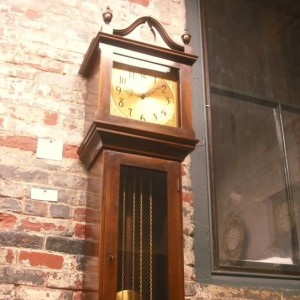Something is wrong with my grandfather clock. Now what?

Like all machines, grandfather clocks become dirty and worn through years of use. This is often when they developed odd behavior or simply refuse to run. So what is to be done? Let’s take a look at the process for having a grandfather clock serviced.
Step 1: Talk to a professional about your grandfather clock
First, you’ll want to speak with a qualified clock repairer. Here are the kinds of things the repairer will probably want to know:
– What brand of clock is it?
– How old is it?
– Is it driven by falling weights? How many?
– Does it play a song on the quarter hours (chime) or does it just count out the hours (strike)?
– What is the clock doing or not doing? When did it start? Have you detected any patterns?
– Has it been serviced before?
– Can you send a photograph or two of the clock?
Before going further, be sure you feel comfortable working with the repair person. Ask for repair estimates and if the work will be warrantied.
Step 2: A first house call to evaluate the clock
House calls may be a thing of the past in many fields, but not so when it comes to large floor-standing clocks. The clock repairer will want to take a look your clock in person. If the clock hasn’t been serviced in a years, chances are very good that it will need to be overhauled. How can your know for sure? Ask to see the clock movement and have the repairer point out the pivot holes in the clock plate. Is there evidence of old, black (or green), dirt-filled oil around the pivots? Ask to see the cut pinions and see if they are dirty too. This dirt — and the associated wear that invariably comes with it — is more than enough to stop a clock. If you are resolved to have it fixed, and the repair estimate sounds fair, it’s on to the next step.
Step 3: Overhaul the movement or (sometimes) replace it
The repairer will take the mechanical parts out of the clock case for service in his or her workshop. These parts include the movement, pendulum, weights, and dial. They will overhaul the movement, taking the mechanism apart completely to clean all of the parts and restore the ones that need it. The repairer will then run the clock for a week or more to be sure that everything is working properly. Certain modern grandfather clocks have movements which are still being manufactured. It can be wiser and more economical to replace this type of movement rather than to overhaul the old one. Ask if this option is available to you.
Step 4: Second house call to Install the movement and configure the clock
Finally, the repairer will bring the serviced parts back and reinstall them into the clock case. The repairer will then make adjustments that can only be made when the movement is in the case such as positioning the hammers that hit the chime rods, making sure the clock is level, and that it is ticking evenly (this is known as being “in beat”). This is a good time to ask any questions you might have about the care and operation of your clock.
After a couple of house calls and a bit of waiting, your grandfather clock can be up and running again.
About the Author:
Dug North buys, sells, and repairs antique mechanical clocks at 307 Market Street, Studio 411, in historic downtown Lowell, Massachusetts. Learn more on his web site ClockFix.com.

